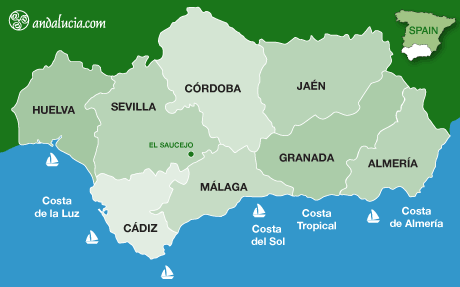EL SAUCEJO
by Saskia Mier
El Saucejo, originally known as La Puebla del Saucejo, is built above the villages of La Mezquitilla and Navarredonda. It has about 4,300 inhabitants.
HISTORY
The origins of El Saucejo date to around 50,000 BC. The discovery of agriculture and livestock in the fourth millennium BC led to the progressive development of a new economy.
The arrival of Roman settlements resulted in the submission of Iberian settlements, such as Irni. Here, they found the most complete copy of the municipal flavian law, known as Lex Irnitana, and another text of equal importance, Senadoconsulto de Cneo Calpurnio Pisón Sr, both currently in the Provincial Archaeological Museum of Seville. These Bronze Latin texts have given international fame to El Saucejo.
The current El Saucejo dates to the late sixteenth century, related to the House of Osuna, once part of the border that divided the Moor and Christian worlds, known as the "Moorish Band": a series of farmhouses used for the economic exploitation of the territory. El Saucejo was given title in the seventeenth century and in 1838 formed its own Town Hall.
THINGS TO SEE
Iglesia de San Marcos Evangelista
The church dates to the first third of the seventeenth century. In the middle of this century a lawsuit was documented for the right of patronage between the Duchy and the Archbishopric to erect a baptismal font, which finally occurred in 1661. The church underwent reconstruction in the mid-eighteenth century after the 1755 Lisbon earthquake. Located in Plaza Cardenal Spínola.
Hacienda de San Pedro
An olive farm dating to the sixteenth century with a unique patio, outdoor garden and two counterweight towers (serving as the winery and mill). Inside the mill, the pressing mats are still preserved. It belonged to the Orden la Compañia de Jesús, which ran a soap factory. Located on Calle San Pedro.
Ayuntamiento
The origins of the Town Hall date to the era where many inhabitants built grain stores after constituting the communal granary in 1750. Located in Plaza de la Constitución.
THINGS TO SEE OUTSIDE THE VILLAGE
Ermita de la Inmaculada
The invocation of the chapel was due, according to Madoz, to an appearance by the Immaculate Conception. During the Civil War, part of the chapel was burned, although an artwork of Baby Jesus remained , having been hidden by a neighbour. Some Islamic remains are preserved in its vicinity, linked to an old mosque. Located in Mezquitilla, off the SE-476.
Cortijo Saucedilla
The farmhouse dates to the first half of the nineteenth century, as Madoz refers to it in his Dictionary. It shows traces of traditional ways of life on a working Andalucian farm, although it is somewhat deteriorated. Located on Camino del Arroyo de la Saucedilla .
Ermita de San José
The chapel dates from the eighteenth century. Located north-east of El Saucejo, on Calle Iglesia in Navarredonda.
Fuente de los Cuatro Caños
The fountain was built in the nineteenth century and the water spring flows from a stone wall, dividing the fountain into two sections. The first section supplies drinking water which then flows down four pipes into a large trough that would have been used by animals. Located in Navarredonda on Camino de la Fuente de los Cuatro Caños.
Fuente del Moro
The "morabito" stream flows in the vicinity of Haza del Duque, running through the waters of Badillos and Santo until it flows into the Corbones River. Located in Mezquitilla, on the SE-476.
Hotels near El Saucejo
Book Hotels near El Saucejo
NATURAL AREAS
El Saucejo has a rich and wonderful landscape, with many places to visit, not only for hikers and cyclists but for everybody who simply wants to enjoy a day out in the open air. Try visiting the streams of Arroyo de la Cañada Estepilla, Arroyo de la Fuente del Moro, Arroyo de la Parra and Arroyo de la Pasada Honda, as well as Cerro Crespillo, Cerro de Pedro Benitez, Puerto de los Barrancos Blancos and Vado Yeso.
GASTRONOMY
Traditional dishes from El Saucejo are porra (similar to salmorejo), lomo relleno (stuffed loin), gazpacho, guiso de esparragos (asparagus stew), habas (broad beans), cocido de tagarninas (wild nettle stew), conejo con "majao" (rabbit), judías blancas (white beans) and acelgas y chorizo (chard with chorizo).
HANDICRAFTS
Local crafts produced in El Saucejo are ceramics, furniture making and saddlery.
FESTIVALS
Cabalgata Reyes Magos
Three Kings procession celebrated on the evening of 5 January.
Fiesta de Candelaria
Celebrated on 2 February.
Día de Andalucía
Celebrated on 28 February.
Carnaval
Celebrated in February.
Fiestas Patronales de San José (Navarredonda)
Celebrated on the weekend before 19 March.
Semana Santa
Holy Week.
Fiesta de San Marcos
Celebrated on 25 April.
Romería de San José Obrero
Celebrated in May.
Feria
Celebrated on the second weekend of August.
Fiesta Virgen del Rosario
Celebrated on 7 October.
Día de la Música
Celebrated one weekend in November.
Fiestas del Castillo
Celebrated on 8 December.
NEARBY PLACES
The neighbouring villages to El Saucejo are Los Corrales, Villanueva de San Juan, Algámitas and Osuna.

